Reunited, and it feels so good
Picture this: laughter echoing across Library Square, coloured light pouring out of the Meeting House windows, embraces shared between old friends and memories flooding back in a wave of nostalgia.
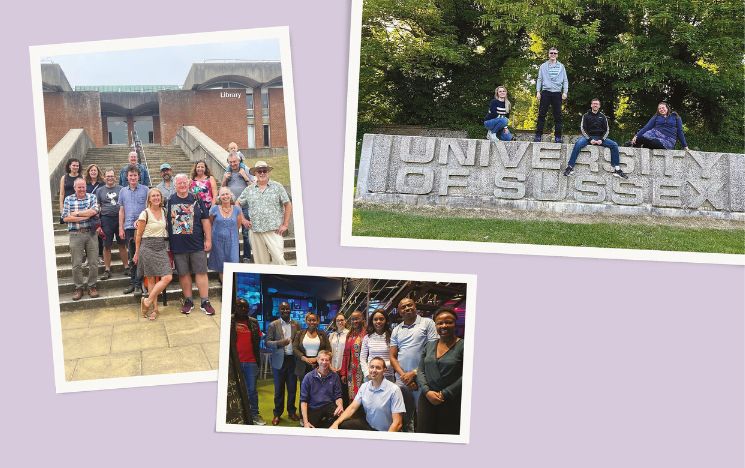
Shared experiences
Each year, groups of University of Sussex alumni get together in gatherings that span continents and cultures to reminisce and reconnect with one another and their younger selves.
One glance at the snapshots from these reunions and you’ll see the warmth and camaraderie that is the hallmark of our Sussex family. From the Mountaineering Club reunion nestled amidst the familiar landscape of our campus, to the alumni gathering in bustling Washington D.C, each reunion has a unique history, bound by the thread of shared experiences and enduring friendships.
Set against the campus backdrop of rolling hills and Basil Spence architecture, members of the Mountaineering Club swap tales of daring climbs and shared triumphs. Meanwhile, a group of Kent House alumni stand proudly beside the Sir Harry Kroto blue plaque, a poignant reminder of the pioneering spirit of Sussex.
Sussex reunions extend far beyond our beautiful campus, reflecting the global nature of the Sussex family. In the bustling streets of Tokyo, alumni from SPRU recently came together to reminisce about late nights in the library and the groundbreaking research that shaped their careers. Despite the miles that separate them, their connection to Sussex remains strong.
In Vienna, one of our alumni volunteer consuls, Massimo Toschi, takes the reins of a diverse group – including a married couple who met at Sussex and a dog named Fridolin – who meet to reminisce about Sussex days and hear from guest speaker and fellow alumnus Professor Yusaf Akbar. In Nairobi, International Officer Khalid Abbas and consul Victor Waweru host a gathering full of smiles that say it all.
The success of the events is testament to the power of community and the dedication of the volunteers who work behind the scenes to keep our Sussex family connected around the world.
Alumni memories
Alumni entering the venue of the reunion jumped into full Sussex mode and mood – as if we had a time travel machine. We experienced both of Sussex’s beloved atmospheres: an academic intellectual event and a spontaneous follow-up networking gathering at the pub! We agreed it was necessary to meet again soon to continue the conversations… but this is to be continued because… Sussex University spirit never ends!
Massimo Toschi (Euro 1992)
It’s those shared experiences [that keep bringing us back together]. The clash of different ages and nationalities that generate stories, good memories and lifelong friendships.
Philip Worsfold (Geography 1996)
To date our group of the class of 68/69 have returned to Brighton as a group no less than four times. We also have regular reunions in our various hometowns/cities scattered all over the UK and in France! It is our shared experiences at Sussex which binds us together: we grew up together during our first time living away from home; we laughed and cried together; we learned together; we shared the excitement of going to one of the most radical universities at that time, in more ways than one.
Christine Pinder (Geography 1968)
Reach out and reconnect
So, as you look at these snapshots of reunions past, let your memories of Sussex wash over you. And if you find yourself feeling nostalgic, longing to reconnect with old friends and relive those Sussex days, know that you are not alone. Reach out! After all, the best reunions are the ones yet to come.
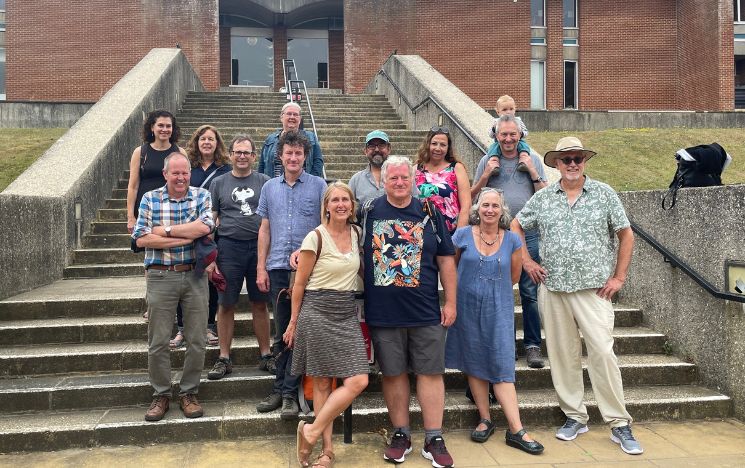
2022 Mountaineering club reunion on campus
The mountaineering club reuniting on campus in 2022 outside the Library.
(From left to right) Far row: Anne Budner, Janet Hardy-(Gould), Hillary Bines Middle row: Peter Carey, Matt Lownds, Dominic Lees, Todd Little-(Siebold), Meredith Brown, Daniel Simon Front row: Jenny Barr-(Johnson), Bob Godden, Sarah (Heller)-McFarlane, Simon Wickham

Alumni visiting the new East Slope development 2022
Daniel Simon, Janet Hardy-(Gould), Anne Budner, Meredith Brown and Bob Godden stood outside the new East Slope Development. They all stayed in the original East Slope flats when they studied at Sussex.
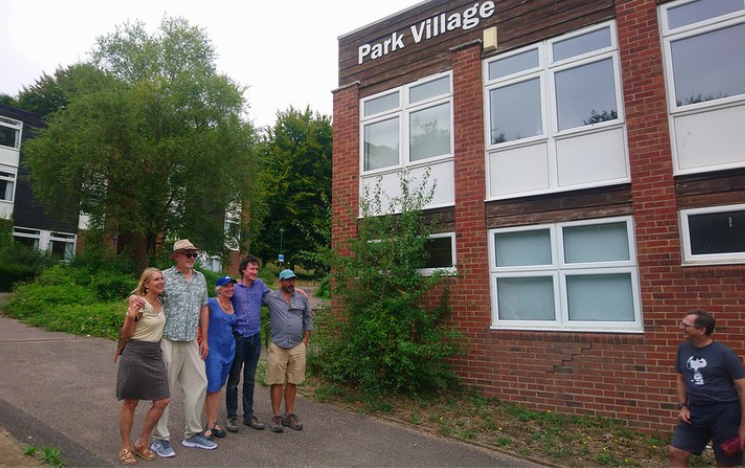
Alumni visiting Park Village 2022
Jenny (Barr)-Johnson, Simon Wickham, Sarah (Heller)-McFarlane, Dominic Lees and Todd Little-(Siebold) stood outside Park Village accommodation. They all stayed in the flats during their time at Sussex.
Matt Lownds can be seen in the corner of the photograph.
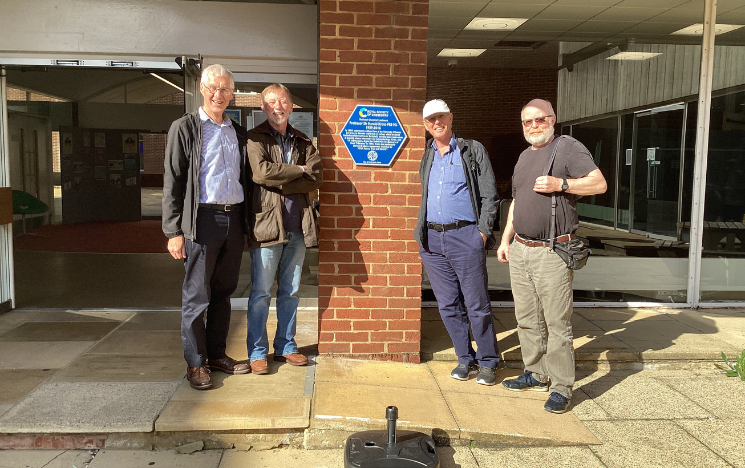
Alumni visiting the Professor Sir Harry Kroto FRS NL chemical landmark blue plaque
Richard Houdmont, John Parsons, Dave Lowson and Simon Hones (stood left to right) standing by the blue plaque on the University of Sussex campus to remember Professor Sir Harry Kroto FRS NL.
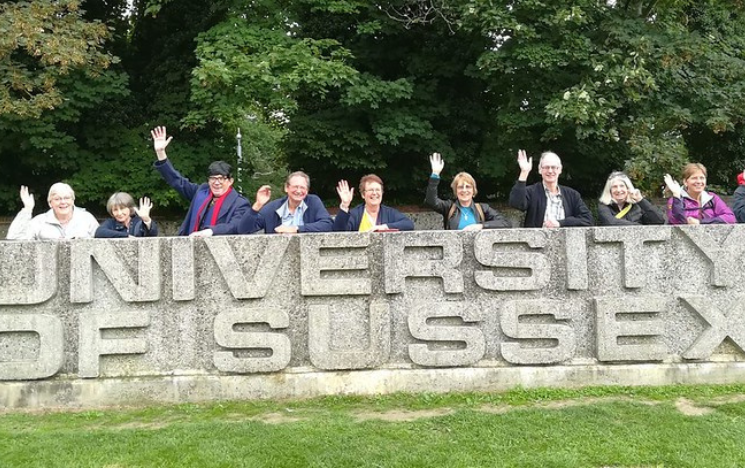
Class of 1968/69 50th anniversary reunion in Brighton in 2018
Photograph provided by Christine Pinder nee Gibson, SocSci 1968-71.
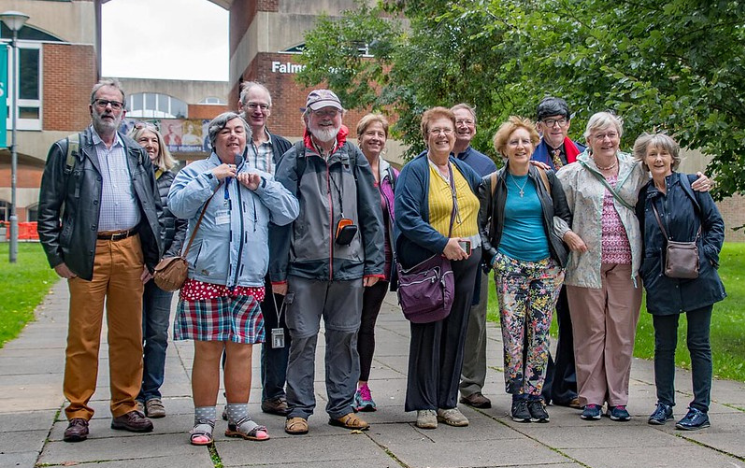
Outside Falmer House Alumni Reunion
Photograph taken at a class of 1968/69 50th anniversary reunion in Brighton in 2018. Provided by Christine Pinder nee Gibson, SocSci 1968-71.
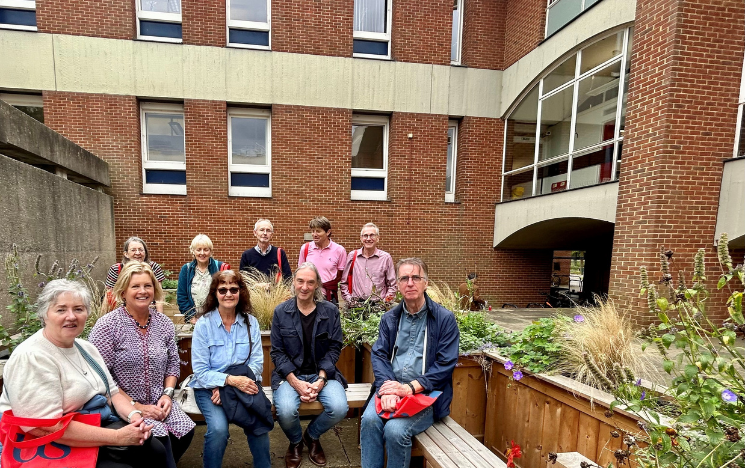
Alumni visiting campus 2023
A group of alumni who studied at Sussex in the 1970s visiting campus in October 2023. Photograph provided by Caroline Rickatson.
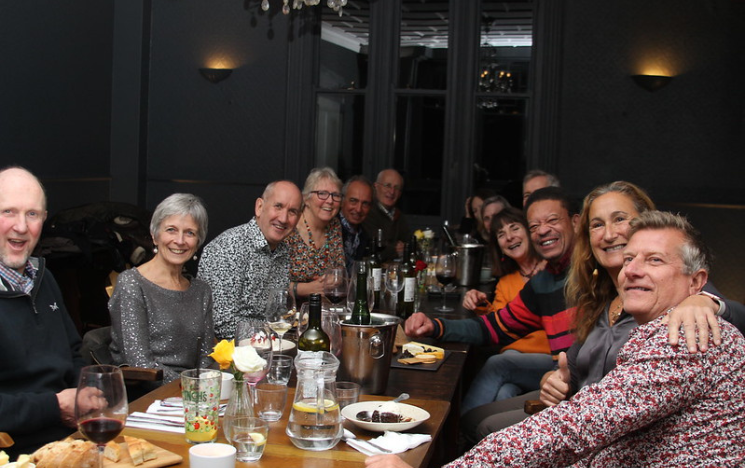
Alumni reunion November 2023
Alumni reunion at the Chimney House November 2023. The group are celebrating their 45th anniversary reunion since they first met at Sussex around 1978. Photo provided by Chris Barraclough (Law 1977).
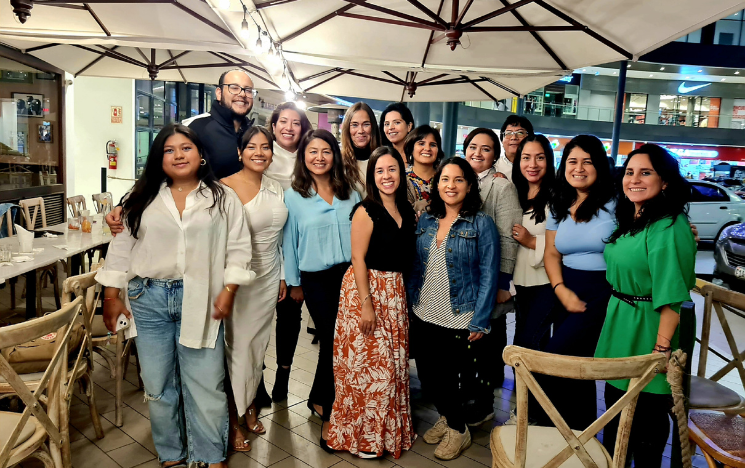
Alumni reunion in Lima, Peru 2024
Alumni in Peru meet in a restaurant in Lima, organised by volunteer alumni consul Zenia Medina.
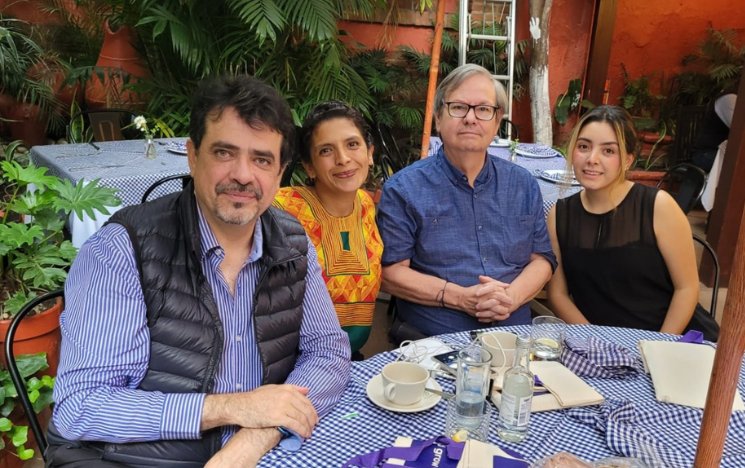
Alumni reunion in Mexico, 2023
Alumni in Mexico meet in a restaurant in Mexico City, organised by volunteer alumni consul Nereyda Cruz Sanchez
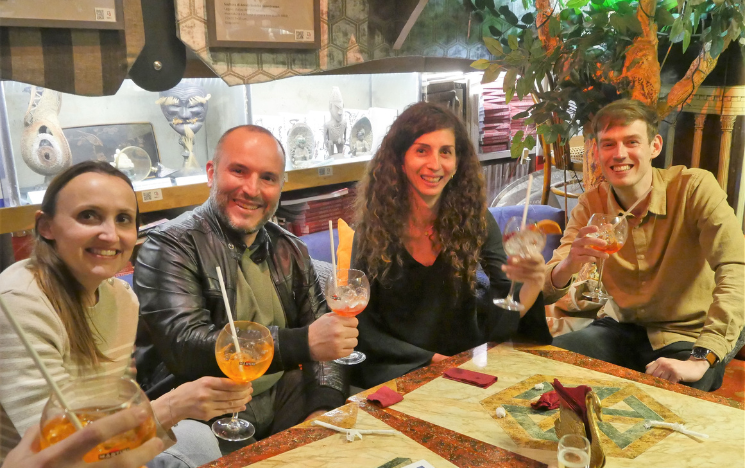
Alumni reunion in Rome, Italy 2022
Alumni in Italy meet in a restaurant in Rome 2022.
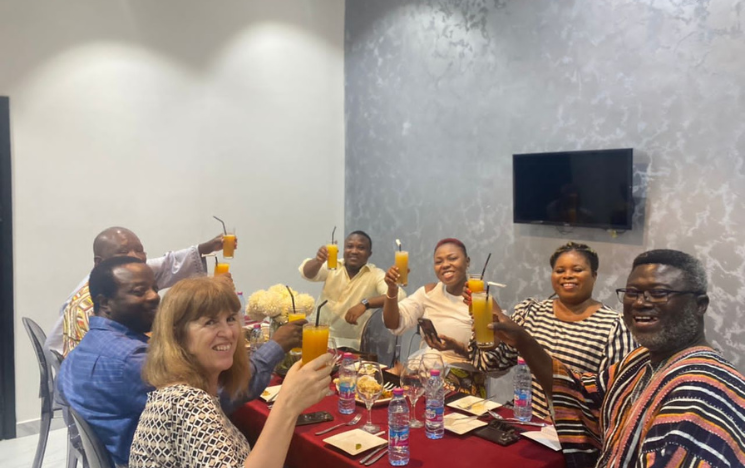
Ghana alumni celebration in Accra March 2022
Alumni in Ghana celebrate One World Week in March 2022.
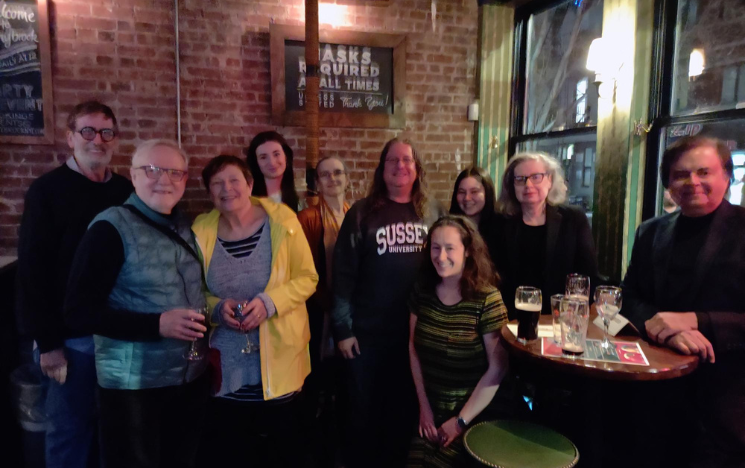
Celebrating One World Week and 60 Years of Sussex in New York 2022
Alumni in New York meet in a bar, organised by volunteer alumni consul Avri Klemer .
Send us your memories
Upload your favourite Sussex photos and share your own special memories of reunions with us via our send us your news webpage